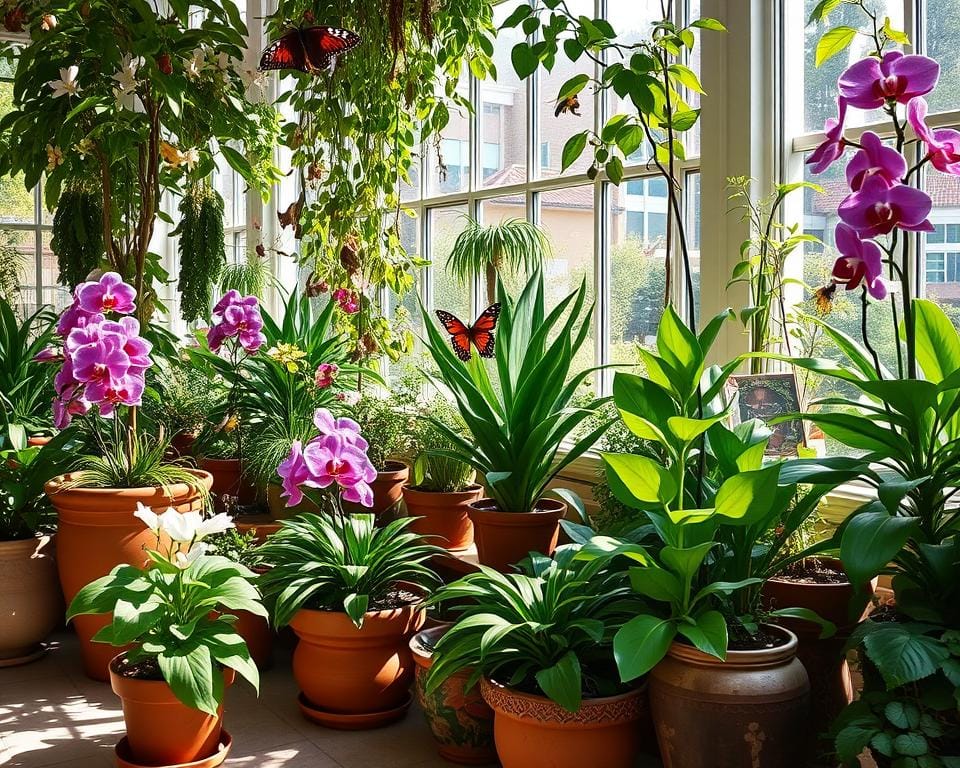Have you ever thought about how indoor gardeners grow fruits, vegetables, and flowers without bees? The answer is in learning about plant pollination and supporting it indoors. But can you make a garden that’s good for pollinators at home? Let’s look at how to attract pollinators to your indoor garden.
Key Takeaways
- Self-pollinating plants like tomatoes and peppers can thrive indoors without external pollination
- Cross-pollinating plants like cucumbers and melons require human intervention to transfer pollen
- Choosing pollinator-friendly houseplants and creating an indoor pollinator garden can support beneficial insects
- Hand pollination techniques like gentle shaking or using a paintbrush can help ensure fruit and vegetable production
- Introducing bees, butterflies, and other pollinators to your indoor garden can boost plant health and yields
Understanding Plant Pollination Needs
Growing plants indoors means knowing how they need to be pollinated for fruits and veggies. Plants are either self-pollinating or cross-pollinating. Each type has its own needs for indoor growth.
Self-Pollinating vs. Cross-Pollinating Plants
Self-pollinating plants like tomatoes, beans, and peppers have both male and female parts in one flower. They can pollinate themselves without help from others. Cross-pollinating plants, however, need pollen moved from one flower to another to produce fruits and veggies. This includes cucumbers, melons, and eggplants.
Examples of Self-Pollinating Plants
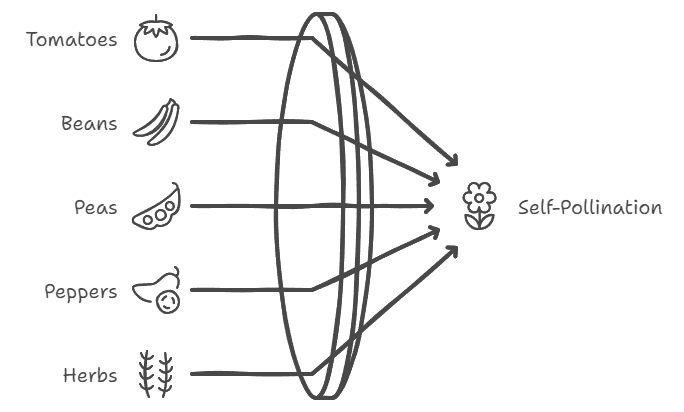
Examples of Cross-Pollinating Plants
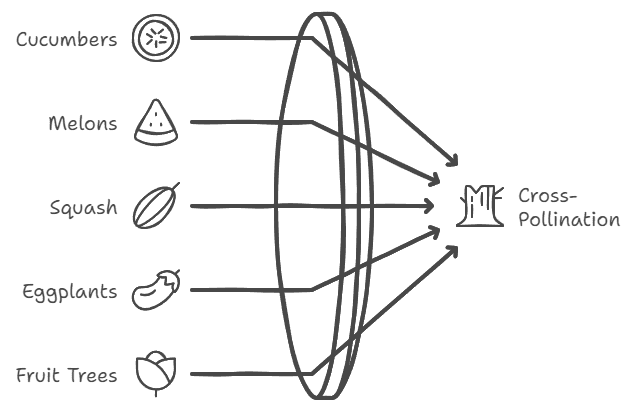
Knowing how different indoor plants pollinate is key to gardening success. By understanding the needs of self-pollinators and cross-pollinators, gardeners can help their plants produce well indoors.
Attracting Pollinators with Indoor Plants
To make an indoor pollinator garden, pick a mix of flowering houseplants that offer nectar and pollen all year. Great choices are nasturtiums, geraniums, lantana, fuchsias, and herbs like lavender, thyme, and rosemary. Place these plants near your greenhouse or indoor garden to draw bees, butterflies, and other pollinators.
Choosing Pollinator-Friendly Houseplants
For your indoor pollinator garden, choose a variety of plants that bloom at different times. This keeps nectar and pollen available for pollinators all season. Include plants with various flower shapes, sizes, and colors to attract different pollinators.
- Nasturtiums: Colorful, easy-to-grow flowering vines that attract butterflies and bees.
- Geraniums: Vibrant, long-lasting blooms that provide nectar for a variety of pollinators.
- Lantana: Clusters of small, tubular flowers that appeal to hummingbirds, bees, and butterflies.
- Fuchsias: Delicate, pendulous flowers that hummingbirds and bees find irresistible.
- Flowering herbs: Lavender, thyme, and rosemary offer both beauty and fragrance to pollinators.
Creating a Pollinator Garden Indoors
Design your indoor pollinator garden with plants grouped together for a beautiful display. Add small water sources like shallow dishes or misters for the pollinators. Keep your plants healthy and pest-free for a welcoming space for pollinators.
“Having a mix of flowers and food crops in a greenhouse can attract pollinators effectively.”
How to Attract Pollinators Indoors
Attracting pollinators to indoor gardens is rewarding and good for the planet. By using a few smart strategies, you can make your home or greenhouse a haven for pollinators. Let’s look at some great ways to invite these important insects into your indoor garden.
One easy method is to keep greenhouse doors or windows open. This lets bees, butterflies, and other helpful insects move between your plants. Adding live pollinators like bees or butterflies can also increase pollination.
For extra help with pollination, try mechanical methods. Gently shaking or using a soft brush to move pollen can work well. This is especially useful for plants that pollinate themselves or need cross-pollination.
To make your indoor garden even more inviting, add plants with lots of nectar. Bees like blue, yellow, white, and purple flowers. Butterflies prefer red and purple. Grouping plants together makes it easier for pollinators to find them.

With these tips, you can create a lively, pollinator-friendly space indoors. You’ll get more fruit and veggies, and enjoy watching these important insects up close.
| Pollinator | Preferred Flower Colors | Flower Shapes They Favor |
|---|---|---|
| Bees | Blue, yellow, white, purple | Tubular, flat, or open-faced |
| Butterflies | Red, purple | Wide, flat, or clustered |
| Hummingbirds | Red, orange, purple | Tubular, pendant, or long-throated |
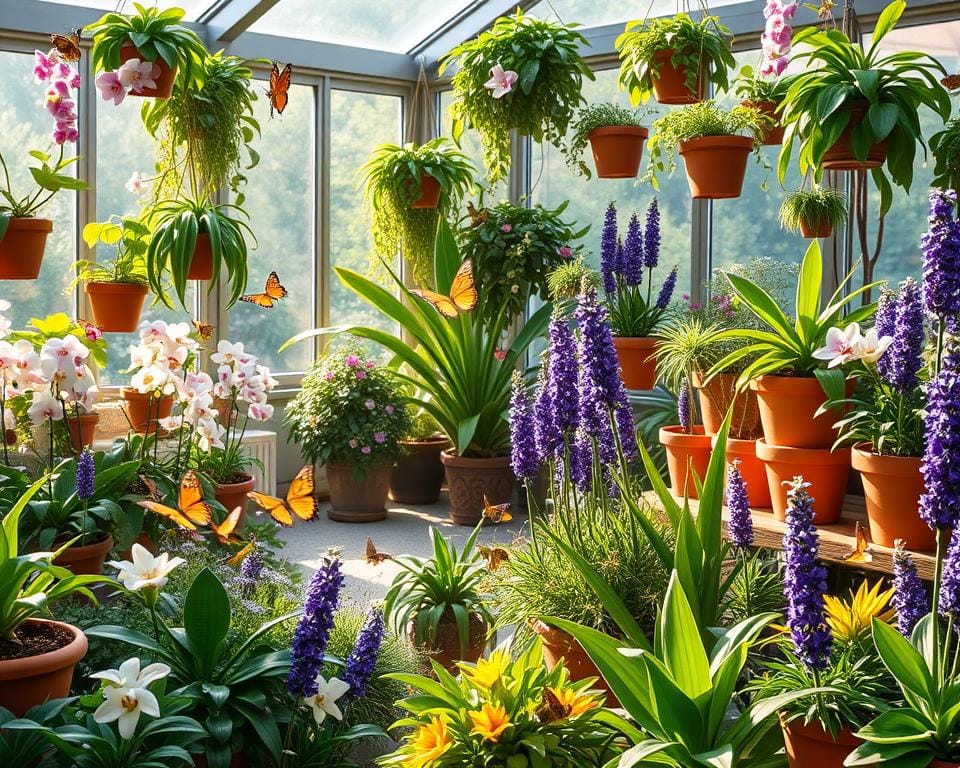
Creating a pollinator-friendly indoor garden helps these vital creatures and boosts your garden’s health and productivity.
Mechanical Pollination Methods
Gardeners often use mechanical pollination because it’s hard to keep bees and butterflies indoors. This method uses tools to move pollen from the male to the female part of a flower. This process is called cross-pollination.
Using Tools for Cross-Pollination
To cross-pollinate plants like cucumbers and beans, gardeners use small paintbrushes or electric toothbrushes. These tools help move pollen between plants since there are no natural pollinators. It’s important to know which part of the flower is male and which is female to pollinate correctly.
Identifying Male and Female Flowers
Figuring out the male and female parts of a flower can be tricky. The male flower has the stamen, where pollen is made. The female flower has the stigma, where pollen lands. For some plants, like cucumbers, the female flowers look like small immature fruit at the base of the flower.
Mechanical pollination is great for indoor gardeners. It helps cross-pollinate plants that need pollen moved between flowers. By knowing how plants reproduce and using the right tools, gardeners can get a good harvest without natural pollinators.
| Tool | Purpose |
|---|---|
| Small Paintbrush | Manually transfer pollen between male and female flowers |
| Electric Toothbrush | Vibrate and dislodge pollen for distribution |
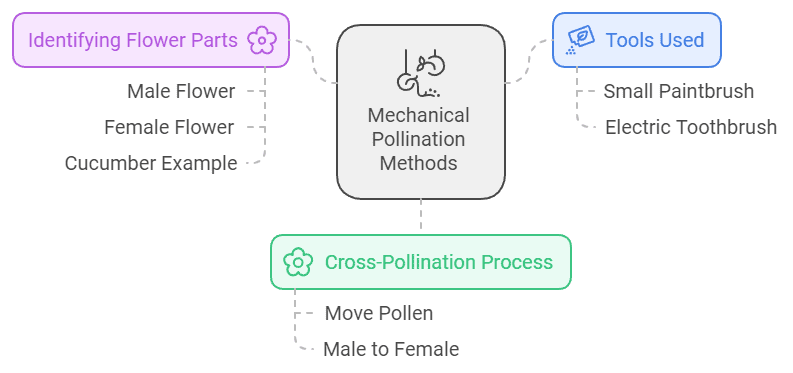
Releasing Beneficial Insects
Introducing bees or butterflies to your indoor plants is another way to pollinate them. This is possible in a small home greenhouse or indoor garden. You can buy and release mason bees or painted lady butterflies to pollinate your plants.
Introducing Bees and Butterflies
Commercial greenhouses often use bees for natural pollination. Bees are key in pollination, boosting garden production a lot. Butterflies also help by feeding and breeding on certain plants. Attracting these insects helps keep your indoor garden pollinated.
Caring for Pollinator Insects Indoors
If you add bees, butterflies, or other pollinators to your garden, make sure they have what they need. Offer nectar-rich flowers, water, and places to nest. Watch the pollinators and help them if they need more food or shelter to stay healthy indoors.
Having many types of flowers and creating a good home for pollinators is rewarding. It helps bring bees and butterflies indoors and supports introducing pollinators to indoor gardens. By using beneficial insects for indoor pollination and caring for indoor pollinators, you ensure pollinator needs indoors and maintain pollinator populations in indoor gardens.
“Leaving aphids can attract beneficial insects like predatory wasps to control pest populations.”
| Beneficial Insect | Pest Control Capabilities |
|---|---|
| Parasitoid Wasps | Can kill up to 71% of common asparagus beetles by parasitizing their eggs |
| Lady Beetles | Consume 100–400 aphids during their development, around 23 aphids per day |
| Ground Beetles | Can decrease weed pressure by 80–90% by consuming weed seeds |
Inviting Pollinators into the Indoor Garden
Attracting pollinators to your indoor garden is a fun challenge. You can do this by leaving the greenhouse door or windows open. This lets bees, butterflies, and other insects come and go easily. Adding brightly-colored, nectar-rich flowers near the entrance can also draw them in.
Choose plants like nasturtiums, geraniums, and blood-red geraniums for your indoor garden. These plants are a hit with bees and butterflies. By drawing pollinators into indoor gardens, you make your space more welcoming to them. This can greatly improve your garden’s productivity.
Bees are key to pollination, helping many plants reproduce. Indoor gardens can pollinate all year, unlike outdoor ones. Bees can boost the yield of plants like tomatoes, peppers, and berries. They increase fruit sets and the number of fruits.
| Plant | Height | Width | Planting Zones |
|---|---|---|---|
| Teenie Genie Lantana | Up to 30″ tall | Up to 30″ wide | N/A |
| Evolution Colorific Coneflower | N/A | N/A | Zones 4-9 |
| Kudos Coral Dwarf Agastache | Up to 20″ tall | 16″ wide | N/A |
| Balmy Lilac Bee Balm | N/A | N/A | Zones 4-9 |
| Harlequin Purple Beardtongue | Up to 22″ tall | 16″ wide | N/A |
| Javelin Forte Deep Rose Spanish Lavender | N/A | N/A | Zones 7-9 |
| VIBE Ignition Purple Salvia | Up to 24″ tall | Up to 24″ wide | N/A |
| Junior Walker Catmint | Up to 16″ tall | 36″ wide | N/A |
| Giga Blue Pincushion Flower | N/A | Up to 15″ wide | N/A |
| SunBelievable Brown Eyed Girl Helianthus | Up to 3′ tall | Up to 3′ wide | N/A |
| Sunset Flash Blanket Flower | Up to 14″ tall | Up to 14″ wide | N/A |
| Colorita Kate Peruvian Lily | N/A | Up to 24″ wide | N/A |
| SuperCal Petchoa | Up to 14″ tall | Up to 18″ wide | N/A |
| Hummingbird’s Lunch Cuphea | N/A | N/A | Zones 8-11 |
| Fiesta Piña Lantana | N/A | Up to 30″ wide | N/A |
By making indoor spaces attractive to pollinators, you can create a thriving garden. This garden benefits from bees, butterflies, and other important insects. With the right plants and open access, you can encourage pollinators to visit indoor plants. Enjoy the rewards of a pollinator-friendly indoor oasis.
Hand Pollination Techniques
For gardeners who want to ensure successful pollination of their indoor plants, hand pollination techniques can be incredibly useful. Whether you’re growing self-pollinating plants like tomatoes, peppers, and beans, or cross-pollinating varieties such as cucumbers and squash, a little manual assistance can go a long way in boosting your harvest.
Gentle Shaking for Self-Pollinators
With self-pollinating plants, a simple gentle shaking or tapping of the flowers can help facilitate the pollination process. This movement helps disperse the pollen from the male part of the flower to the female part, mimicking the natural pollination that would occur from wind or insect activity outdoors. This method is particularly effective for tomatoes, peppers, and beans.
Paintbrush Pollination for Cross-Pollinators
Cross-pollinating plants, on the other hand, require the manual transfer of pollen from the male flower to the female flower. One effective technique is to use a small paintbrush to gently collect pollen from the male flower and then transfer it to the female flower. This manual pollination ensures adequate fertilization for fruits and vegetables to develop properly, especially for cucumbers, melons, pumpkins, and squash.
| Plant Type | Pollination Method | Benefits |
|---|---|---|
| Self-Pollinating (Tomatoes, Peppers, Beans) | Gentle Shaking | Mimics natural wind/insect pollination |
| Cross-Pollinating (Cucumbers, Melons, Squash) | Paintbrush Pollination | Ensures adequate fertilization for proper fruit development |
By mastering these hand pollination techniques, indoor gardeners can ensure their plants receive the attention they need to thrive and produce bountiful harvests, even in the absence of natural pollinators. With a little care and attention, you can reap the rewards of a truly successful indoor garden.
Supporting Pollinators at Home
As an indoor gardener, you’re not just taking care of your plants. You’re also helping our local pollinators. By making your indoor garden a place where pollinators can thrive, you help them and support the environment.
Benefits of Indoor Pollinator Gardening
Supporting pollinators in your garden is good for your plants and the ecosystem. Bees and butterflies are key to healthy ecosystems. By making your garden friendly to them, you help your harvest and protect pollinators.
About 80% of plants need pollinators to make seeds. Over three-quarters of crops that feed us rely on these creatures. By letting pollinators into your garden, you’re helping the natural world and biodiversity.
Providing bee houses and plants that bloom all year helps pollinators. This benefits your garden and the environment outside your home.
“Attracting and supporting pollinators in your indoor garden is not only good for your plants, but also helps to maintain a healthy, diverse ecosystem.”
Indoor pollinator gardening means a better harvest and helping the planet. Your garden can be a safe place for these important creatures. It supports biodiversity and creates a healthier environment for everyone.
Troubleshooting Pollination Issues
If you’re having trouble with pollination in your indoor garden, there are a few things to check. Make sure your plants get enough light, air, and moisture. These things help with pollination. Also, look for pests or diseases that might be stopping flowers or fruits from growing.
For plants like blueberries, blackberries, and melons that need cross-pollination, try adding beneficial insects. Bumblebees work great in greenhouses because they can see well and work in cooler temperatures. They’re better than honeybees for this job.
If shaking or using a paintbrush doesn’t help, try other ways to pollinate. For plants like tomatoes and peppers that pollinate themselves, a simple tap on the flowers can work. For plants that need cross-pollination, you might need to move pollen from the male to the female flowers by hand.
| Pollination Challenge | Potential Solutions |
|---|---|
| Inadequate light, airflow, or humidity | Optimize environmental conditions |
| Pests or diseases affecting flowers/fruits | Identify and address pest or disease issues |
| Cross-pollination required | Introduce bumblebees or use manual pollination techniques |
| Self-pollination issues | Gently tap flowers or use a paintbrush to transfer pollen |
By fixing these common pollination problems, your indoor garden can flourish. It will produce lots of tasty fruits and veggies. Remember, solving troubleshooting pollination problems in indoor gardens, addressing pollination challenges in greenhouses, and solving pollination issues for indoor plants is crucial for success.
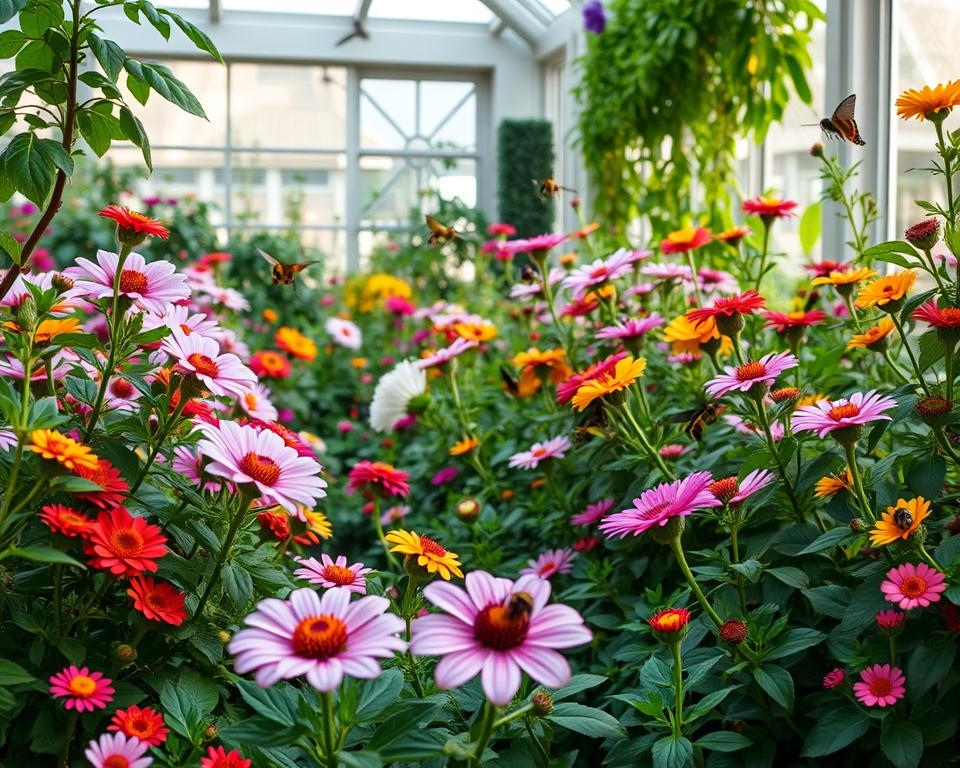
“Bee pollination offers a cost-effective and efficient alternative to hand pollination but may not be suitable for greenhouses relying heavily on pesticide use.” – Ryan Hill
Conclusion
Growing a thriving, productive indoor garden is easy with a few key steps. Start by understanding the pollination needs of your plants. Then, choose houseplants that attract pollinators. Finally, mix mechanical and natural ways to pollinate your plants for a great harvest.
This approach helps your indoor crops get pollinated and grow well. It also supports biodiversity and the health of local ecosystems.
To attract pollinators indoors, pick a variety of plants with lots of nectar. Make sure they have food all year and don’t use pesticides. This way, you can make your indoor space a lively place for pollinators. It will help your local ecosystem stay healthy and sustainable.
With the decline of pollinators, it’s more important than ever to support pollinators in indoor spaces. Creating a garden that welcomes pollinators can really help. It boosts biodiversity, increases food production, and keeps our natural systems strong for the future.
FAQ
Can I grow fruits, vegetables, and other flowering plants indoors and still have them successfully pollinated?
Yes, you can grow fruits, vegetables, and flowering plants indoors and get them pollinated. There are two main types of plants: self-pollinating and cross-pollinating.
What is the difference between self-pollinating and cross-pollinating plants?
Self-pollinating plants like tomatoes, peppers, and beans pollinate themselves. Cross-pollinating plants like cucumbers and melons need pollen moved from one flower to another to produce fruits and vegetables.
What are some examples of self-pollinating plants that can thrive indoors?
Self-pollinating plants that do well indoors include tomatoes, beans, peas, peppers, eggplants, and many herbs. They have both male and female parts in each flower, so they can pollinate themselves.
What are some examples of cross-pollinating plants that require special attention indoors?
Cross-pollinating plants like cucumbers, melons, and squash need help to produce fruits and vegetables. They have separate male and female flowers. Pollen must be moved from the male to the female flower for them to work.
How can I attract pollinators to my indoor garden?
To draw pollinators to your indoor garden, pick a mix of plants that offer nectar and pollen. Try nasturtiums, geraniums, lantana, fuchsias, and herbs like lavender and thyme. Place these near your plants to attract bees and butterflies.
What strategies can I use to facilitate pollination in an indoor growing space?
To help pollination in your indoor garden, keep greenhouse doors or windows open for airflow and pollinators. You can also add bees or butterflies or use a paintbrush for pollination.
How can I identify the male and female parts of a flower to effectively pollinate cross-pollinating plants?
The male flower has the stamen, where pollen is made. The female flower has the stigma, where pollen lands. For plants like cucumbers, the female flowers look like small immature fruit at the flower base.
What are the benefits of attracting pollinators to my indoor garden?
Attracting pollinators helps your plants pollinate and is good for the environment. Bees and butterflies are key to healthy ecosystems. By helping them, you’re supporting nature’s balance.
What should I do if I’m experiencing pollination problems in my indoor garden?
If pollination isn’t working, check your plants’ light, airflow, and humidity. Look for pests or diseases that might be the issue. If needed, try adding beneficial insects or different pollination methods.
Source:
6 Gardener-Approved Tips to Attract Helpful Pollinators in Your Yard

